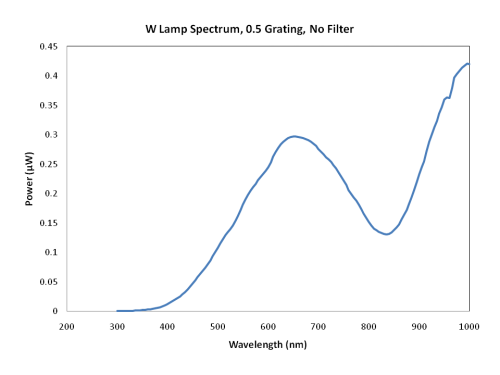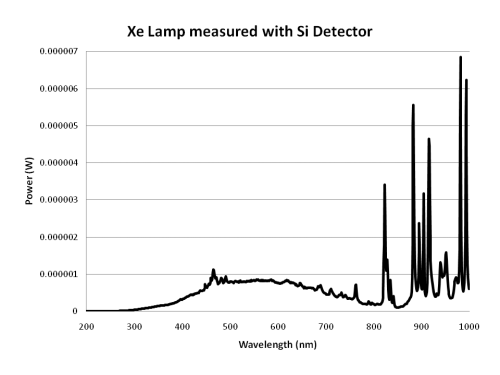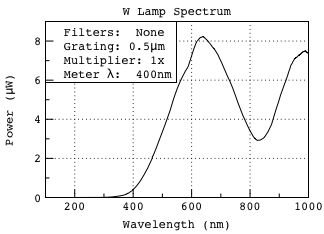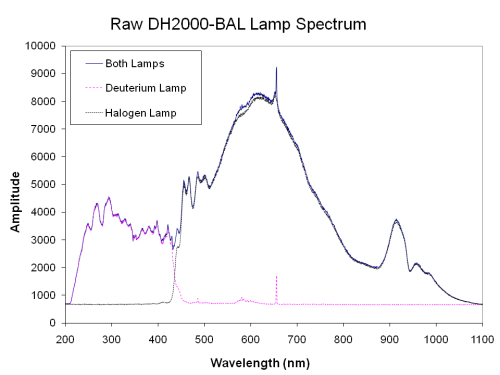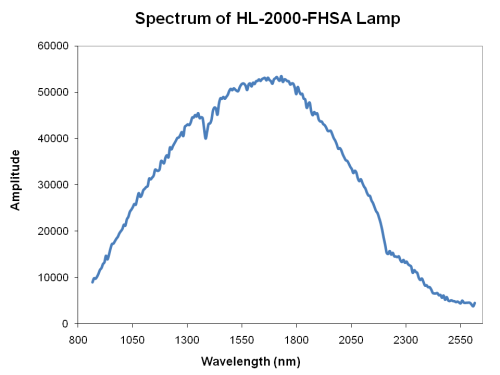This is an old revision of the document!
Table of Contents
Optical Spectrometers
Located in David McIntyre's lab Weniger 118.
Scanning Monochromator
The Scanning Monochromator can make transmission, specular reflection, and diffuse reflection measurements on thin film, single crystal, and powder samples.
Sources
There are two broadband sources for the Scanning Monochromator. The W-halogen lamp is used in the visible and NIR (note spectrum depends on filters and grating used):
and the Xe lamp in the UV-and visible.
Detectors
There are two detectors for the Scanning Monochromator. The Silicon detector is 13 mm^2 and works in the UV-Vis range 350-1100 nm (down to ~1.1 eV).
The InGaAs detector is used for NIR measurements and is 3.1 mm^2 and thus it's is much more difficult, compared to the Si detector, to capture all the light. This detector can work in the range of 800-1800 nm.
Gratings
There are five sets of gratings for the monochromators - 0.25 µm, 0.5 µm, 1.0 µm, 2.0 µm, and 4.0 µm. The number indicates the wavelength at which the gratings perform the best. Typically, for UV-Vis measurements, you want to use the 0.5µm gratings, because the lamp is fairly weak at this wavelength, yet very intense at 1.0 µm. Thus, you're unlikely to get a usable signal at 500 nm with the 1.0 µm gratings, but you will still get a strong a signal at 1 µm when using the 0.5 µm gratings.
Sampling Accessories
The Scanning Monochromator has an Oriel 70491 integrating sphere to make diffuse reflection measurements.
Ocean Optics Spectrometer
The Ocean Optics Spectrometer can make transmission, specular reflection, and diffuse reflection measurements on thin film, single crystal, and powder samples. Diffuse reflection measurements can only be made on strongly diffusely reflecting materials.
Detectors
The Ocean Optics spectrometer has two detectors: Ocean Optics HR 4000 and Ocean Optics NIR256-2.5.
An Ocean Optics HR 4000 spectrometer was used to take the ultraviolet-visible spectra. The HR 4000 has a 3648-element CCD-array detector with optical resolution of 0.27 nm. The ultraviolet-visible measurements spanned a wavelength range from 200 nm to 1150 nm.
Ocean Optics NIR256-2.5 spectrometer was used to take the visible-near infer red spectra. The NIR256-2.5 has an InGaAs detector array with an optical resolution of 6.85 nm. The visible-near infer red measurements spanned a wavelength range of 850 nm to 2600 nm.
Light Sources
An Ocean Optics Mikropack DH-2000-BAL Deuterium Tungsten Halogen Light Source was used for the ultraviolet-visible measurements and an Ocean Optics Mikropack HL-2000 Tungsten Halogen Light Source was used for the visible-near infer red measurements. The spot size and incidence angle for both instruments are approximately 1.5 mm and 0 º.
Software & Data Analysis
- Levi Kilcher wrote an Excel sheet called index calc (2006 version is here) to analyze R & T data from the grating spectrometer, to get index, band gaps etc. Here is a help file for the index calc spreadsheet. See also Reports page for presentation, and Levi Kilcher's thesis on thesis page.
- The Index_Calc2006.xls spreadsheet was fixed by James Haggerty (01/31/15). The Macro buttons should now be functional
- Scout software is being implemented by Aaron Kratzer (2013). Working user manual
- Update from James Haggerty (02/08/15)
- Here is a .zip file, “” which contains a file structure to help keep you organized as well as all the spreadsheets needed to calculate the band gap for a material.
- There are quite a few spreadsheets in this zip file and as a result it is rather large (19Mb), so it may take a while to download.
- Inside the “Optical_Data” folder you will find another folder named “Material_Name”, copy this folder (create a new copy to save the original for adding materials) and rename it for the material you are studying. For example if you are studying ZnO, then name the folder “ZnO”.
- Inside the “Material_Name” folder you will find a folder named “Sample_ID”, copy this folder (create a new copy to save the original for adding samples) and rename it with the sample ID for the individual sample you are studying.
- Inside the “Sample_ID” folder you will find three more folders, GS for Grating Spectrometer data, OO for Ocean Optics Fiber Optic Spectrometer data, and Optical Comparisons for comparing measurements between the two spectrometers.
- Inside both the GS and OO folders are similar folders, first there are folders for raw data (one folder for each type of measurement that can be made, for example you can make a measurement on the GS using the Xe lamp and the Si Detector)
- Next there are the folders “Optical_Plots”, “Optical_Comparisons”, and “Optical_Calculations”.
- Inside the “Optical_Plots” folder are two spreadsheets, “Optical_Plots_MultiRange” and “Optical_Plots_SingleRange”
- “Optical_Plots_SingleRange”: First, make sure to fill out all the blue cells in the spreadsheet.
- This spreadsheet allows you to select an appropriate range to plot all of your data. For example, if the ends of your data are noisy this spreadsheet allows you to select only the good data to be plotted.
- “Optical_Plots_MultiRange”: First, make sure to fill out all the blue cells in the spreadsheet.
- This spreadsheet works similar to “Optical_Plots_SingleRange” but now you can concatenate two data sets together as well as select off noisy end points.
- There are instructions in each spreadsheet, so be sure to read them carefully.
- Inside the “Optical_Calculations” folder there are the spreadsheets “Index_Calc2015”, “OO_make_Int_Step_UV-IR”(OO folder only), “Optical_Allowed_Band_Gap_Calc”, and “Optical_Forbidden_Band_Gap_Calc”.
- If you plan on combining OO-NIR data with OO-UV-Vis data to calculate the absorption coefficient, then I suggest you first us the spreadsheet “OO_make_Int_Step_UV-IR”, this will make the T and R data both integer steps (needed for the Index_Calc spreadsheet), by either averaging to reduce the amount of data (UV-Vis) or by doing a simple linear interpolation to add data points (NIR), and includes a before and after comparison plot to show that the interpolation did not harm the data.
- This should be done before using the “Optical_Plots_MultiRange” spreadsheet to combine the two data sets.
- As with all of the spreadsheets, blue are entry cells, the rest should not be touched.
- “Index_Calc2015”: works the same as “Index_Calc2006” but has been updated to the latest version of Excel, as of 02/08/15
- “Optical_Allowed_Band_Gap_Calc” and “Optical_Forbidden_Band_Gap_Calc” work the same.
- These are to be used after “Index_Calc2015” as the input is just the absorption coefficient.
- You can plot two different data sets on top of each other to determine band gaps using the linear fit in Excel
- You define the range over which to apply the linear fit, then take the equation and determine the band gap
- Or you can plot a single data set, just don't use the inputs for the second data set.
- Inside the “Optical_Comparisons” folder is a spreadsheet named “Optical_Plots_Comparisons”
- This spreadsheet works similar to “Optical_Plots_MultiRange” but is designed for comparing two data sets in the same range.
- Getting the formatting in this spreadsheet correct can be very involved so make sure to read all of the comments before proceeding.
Documentation
There is a manual for the OO spectrometer located permanently in Wngr 118. Never remove it from that room. The manual is based on some of the following documentation:
- OO Fiber Optic Spectrometer Manual written by Josh Russell; last updated 2009.
- Ocean Optics Walkthrough - Emmeline Altschul, 2011
Optical data
| Date | Author | Title | Notes | |
|---|---|---|---|---|
| - | - | Optical constants from Sopra labs | Optical constants of many different materials. Widely quoted site. | |
| Journal of Physical and Chemical Reference Data 9, 561 (1980) | H. H. Li | Refractive Index of Silicon and Germanium and Its Wavelength and Temperature Derivatives | Exhaustive compilation of ref. ind. of Si, Ge, temp dep etc. Available at NIST reprint site. | |
| Journal of Physical and Chemical Reference Data 13, 103 (1984) | H. H. Li | Refractive Index of ZnS, ZnSe, and ZnTe and its wavelength and temperature derivatives | Exhaustive compilation of ref. ind. of ZnCh temp dep etc. Available at NIST reprint site. | |
| Melles Griot Technical Manual, Materials Properties | Melles Griot | Materials Properties | Good compilation of refractive index, transmission of different kinds of glasses - BK7, suprasil, CaF, crystal quartz, etc. Also silicon and germanium. | |
| Melles Griot Technical Manual, Optical Coatings | Melles Griot | Optical Coatings | Good discussion of coatings and materials, reflection, angles of incidence, phase changes, fringes etc. |
